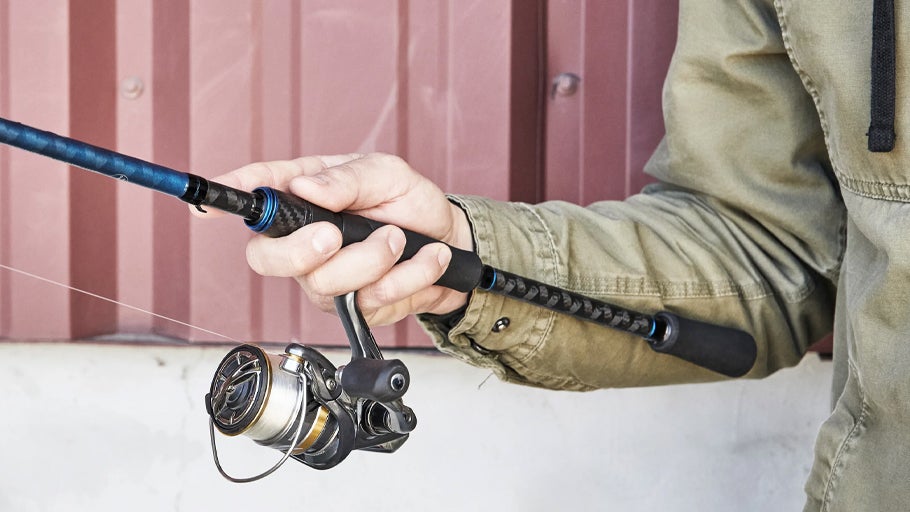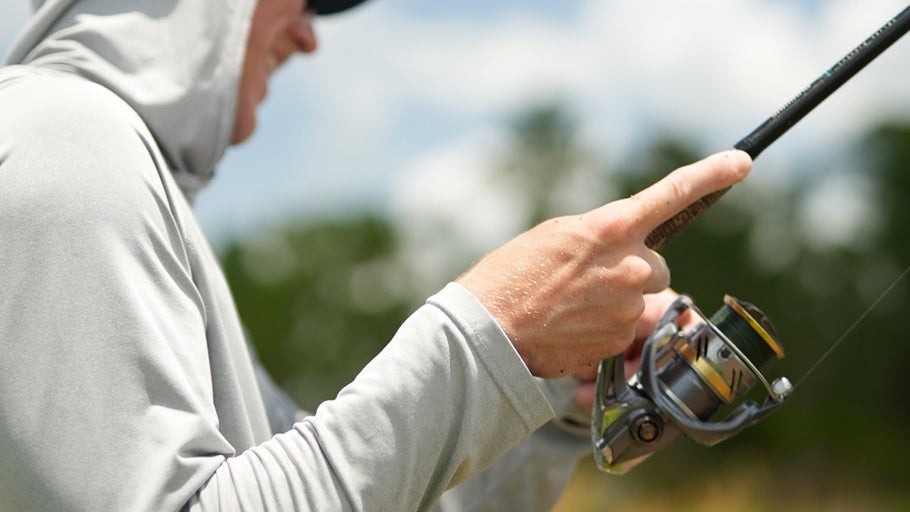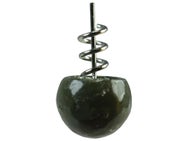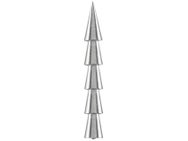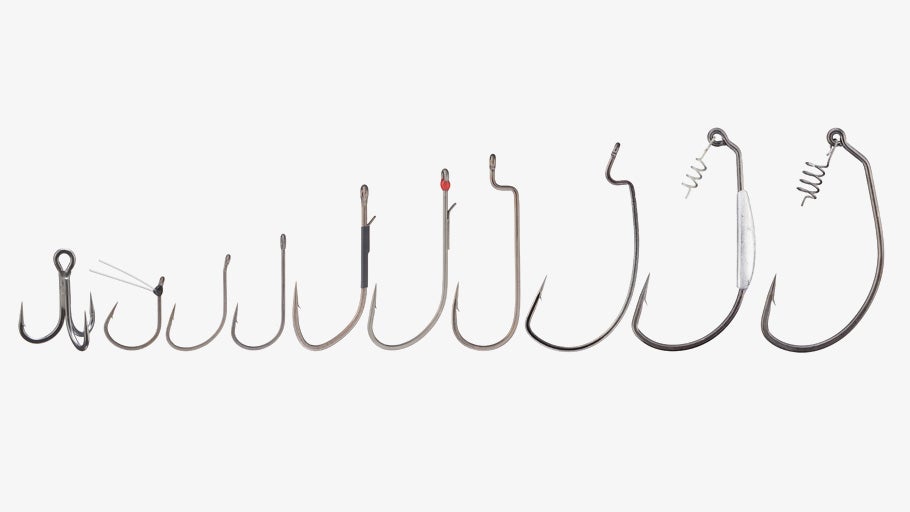
Terminal Tackle Gear Guide
Beyond sinking a hook and lure to the bottom, bass fishing sinkers are used to increase casting distance, maximize feel, and ultimately present lures in a natural and alluring position that makes fish recognize them as mouth-watering prey. When it comes to choosing the right weight for a particular application, the variety of options can be overwhelming, especially if the technique is unfamiliar, so this article aims to shed light on different forms of terminal tackle to instill more confidence when you click the "add to cart" button.
Terminal tackle like split rings, snaps, and swivels also present another challenge, as the sizing is often inversely correlated to fishing hooks, leaving many anglers unsure about what size to purchase when it's time to swap out hooks or reduce line twists. In this Gear Guide, we'll identify common fishing weight shapes and their respective applications, examine the advantages and disadvantages of various weight materials, and explore whether or not there's a clear sizing standard for split rings, snaps, and swivels.
Weight Shapes and Sizes
Worm, Flipping, and Punch Weights
Worm, flipping, and punch weights fall into the same "bullet" weight category as they're poured with a cylindrical base and wedge-shaped point that allows them to slip through cover and sink Texas-rigged soft plastic lures to the bottom. Most small bullet weights in the 1/8-oz to 3/8-oz sizes are commonly called "worm" weights and often feature a slender profile in lightweight sizes that are best paired with shallow water presentations and finesse baits, like worms. Flipping weights maintain a bullet style profile like a worm weight, however, they're typically offered in heavier sizes with a bulkier build that allows them to penetrate vegetation and heavy cover. Punching weights come in similar heavyweight sizes as flip weights but often include a skirt keeper fitting that allows anglers to easily apply a banded skirt to increase the profile of their presentation.
Drop Shot Weights
Drop shot sinkers are built with strategically placed line clips that elevate soft plastics off the bottom when attached to the tag end of a Palomar knot. Often categorized by shape and line tie, drop shot weights come in teardrop, cylinder, or cannonball shapes with closed or "clip" style line ties that cater to different fishing styles. If you're fishing lake bottoms composed of snag-ridden cover, you may prefer a low-profile cylinder weight to reduce snags, but when fishing open water, the rounded shape of a teardrop or cannonball provides more feel and deflects off rocks better. Weights with a clip line tie attach quickly, don't require a knot, and are typically associated with vertical fishing as they're built to slide off when stuck, while closed-eye line ties provide a more secure knot connection that's preferred when casting.
Free Rig Weights
Free rig weights are similar to drop shot weights, but instead of the weight being rigged in a fixed position, they're built with a circular eyelet that allows the weight to slide up and down your mainline. The enlarged opening lets the line slide more freely than a traditional unpegged Texas rig, giving your soft plastic lure a natural free-flowing appearance with unique falling action as it hovers slowly through the water column.
Nail Weights
Perfect for making small changes to your soft bait presentations, nail weights are designed to be inserted directly into soft plastic lures to customize weight, increase casting distance, tune the ideal rate of fall, and give your Neko worms a tail-up scoot across the bottom. The sharp point and barbs on nail weights increase their holding power in soft baits, but you'll want to add a dab of super glue to ensure they remain locked in place when making long casts, catching lots of fish, or fishing around cover. Nail weights make a great addition to any angler's tacklebox and are essential for a productive stick bait fishing tactic known as Neko rigging.
Carolina Rig Weights
Often referred to as barrel, cylinder, or egg weight due to their varying shapes, Carolina rig weights are sliding sinkers that trail in front of a bead, swivel, leader, hook, and your favorite soft plastic lure to drag the bottom through rocks, wood, and vegetation. Before the advent of expensive fish-finding electronics, heavy egg sinker Carolina rigs allowed anglers to determine if the bottom was hard or soft, detect rocks or grass, and learn whether an area was holding fish.
Split Shot Weights
Split shot weights easily attach to your fishing line in a fixed position by crimping them onto your mainline with a squeeze of the pliers. Reusable split shots are just as easily removed by pinching the "ears" on the outside, but some anglers prefer the standard round shape to reduce potential issues with line twists. Perfect for creating a simplistic finesse rig or adjusting on the fly, split shot weights are great for making small incremental changes to your presentation while avoiding line-weakening knots.
Weight Composition
Bass fishing sinkers not only come in a variety of shapes and sizes, but they're also made from different materials that provide distinct advantages or disadvantages when it comes to bottom contact feel, bite detection, cost, and acoustics. Fishing weights from overseas manufacturers are often measured in grams so we have included a size conversion chart below:
| Ounces (fraction) | Ounces (decimal) | Grams |
| 1/32 oz | 0.3125 oz | 0.88 g |
| 1/16 oz | 0.0625 oz | 1.77 g |
| 1/8 oz | 0.125 oz | 3.54 g |
| 1/4 oz | 0.25 oz | 7.09 g |
| 3/8 oz | 0.375 oz | 10.63 g |
| 1/2 oz | 0.5 oz | 14.17 g |
| 5/8 oz | 0.625 oz | 17.72 g |
| 3/4 oz | 0.75 oz | 21.26 g |
| 1 oz | 1 oz | 28.34 g |
Tungsten
Known for their ability to transmit enhanced feel back to the angler, tungsten weights feature a high-density construction that allows anglers to easily detect changes in bottom composition and subtle bites. Tungsten is almost twice as dense as lead, so it has a smaller profile which is beneficial for punching through heavy cover or adding nail weights to slender, soft plastics. One major drawback of tungsten is the cost. Because it carries the highest melting point of any metal, it requires specialized production equipment, which translates to an increased price tag per weight.
Lead
Lead is the most common material used in the production of bass fishing lures, as it offers significant advantages when it comes to density, softness, and cost. The low melting point of lead allows it to be easily formed into different shapes and fishing lures like jigs, spinnerbaits, buzzbaits, and more. Lead weights may be less dense than tungsten, but they still provide great feedback and have a cost-compelling design that often makes them the preferred option when fishing in snaggy areas.
Brass/Steel
Typically paired with a glass bead and used for Texas or Carolina rig fishing, brass and steel weights produce a proven clicking sound that attracts bass when dragged across hard lake bottoms. Loud acoustics make them an excellent choice for dirty water fishing situations, but their low-density construction gives them an oversized profile which is less desirable for anglers who need to create a more compact finesse presentation.
Tin/Bismuth
Developed as an eco-friendly alternative to lead-based fishing products, tin and bismuth materials are two-thirds the density of comparable lead, meaning they can be formed into a larger profile and use less weight. Tin and bismuth weights are becoming popular in states with lead fishing restrictions.
Terminal Tackle Sizing
Over the years, the Tackle Warehouse staff has held many spirited arguments about the sizing standards for various forms of terminal tackle like split rings, snaps, and swivels. After verifying our inventory, we found a few universal trends, but we ultimately learned that each manufacturer has their own interpretation of wire gauge and breaking strength when assigning a particular number to each size.
Split Rings
Split rings serve many purposes in bass fishing but are most commonly used to attach treble hooks to lures or serve as a line tie. Pictured above are four size #4 split rings from different manufacturers, each with different wire gauges, dimensions, and breaking strengths. Despite tons of variance between brands, it's important to note that for every manufacturer, as the split ring "size" number increases so does its breaking strength and diameter, with #1 being the smallest and #10 being the largest. In most cases, it's best to start with a size #3 or #4 split rings for crankbaits and topwater lures, but you may be closer to a size #4, #5, or #6 if you're replacing split rings on a glidebait or large swimbait.
Snap Sizing
Snaps are primarily used to free up the action of crankbaits or topwater and facilitate quick changes between lures, allowing anglers to hone in on the optimal color or size in a hurry. Snap sizing works the same as split rings where the sizing number increases with strength and dimensions, but keep in mind the shape and sizing vary between manufacturers. A size #3 snap from four different brands is shown above to display the variance in shape, wire gauge, and breaking strength.
Swivel Sizing
Swivels are used to reduce line twists, are essential for rigging up a Carolina rig, and are often used on lures that move a lot of water like flutter spoons or inline spinners. Unlike split rings and snaps, swivel sizing doesn't include any standard size trends, with brands interchangeably using large or small numbers to represent both ends of the size spectrum. The best way to confirm the direction of sizing is to verify the manufacturer's size-to-breaking strength chart to gauge if the numbered sizing runs small to large or large to small.
Swivel Types
Barrel Swivel: This is the most basic type of fishing swivel, ideal for medium- to light-duty fishing applications. It consists of a barrel-shaped body, a pivoting joint in the middle, and two metal rings attached on either end.
Crane Swivel: Crane swivels have a more elongated shape designed to handle heavy loads and are commonly used in saltwater fishing for trolling, deep-sea, and live bait fishing.
Rolling Swivel: Rolling swivels feature a slender cylindrical central section that allows them to minimize line twists when subjected to significant pressure. They generally perform better under heavy loads.
Ball-Bearing Swivel: This is a more advanced fishing swivel built with a ball-bearing mechanism that allows for smooth and consistent rotation under heavy loads. It offers the highest performance, strength, and durability ratings compared to other swivels.
Final Thoughts
Just like choosing the best fishing hook, as you spend more time fishing a particular brand of weights, split rings, snaps, or swivels, you'll develop a preference and become more confident selecting the perfect size. Tackle Warehouse always includes a prepaid return label with every shipment, so when you're selecting terminal tackle it's best to grab a couple of sizes to familiarize yourself with the product and determine the ideal size, knowing you can return the incorrect size at no cost.
Related Articles

